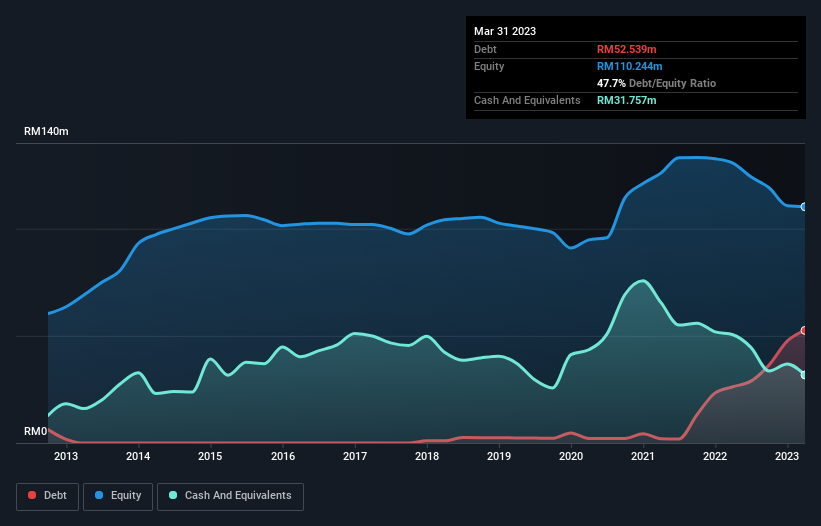
Warren Buffett famously said, 'Volatility is far from synonymous with risk.' So it might be obvious that you need to consider debt, when you think about how risky any given stock is, because too much debt can sink a company. Importantly, G Capital Berhad (KLSE:GCAP) does carry debt. But the more important question is: how much risk is that debt creating?
What Risk Does Debt Bring?
Debt is a tool to help businesses grow, but if a business is incapable of paying off its lenders, then it exists at their mercy. In the worst case scenario, a company can go bankrupt if it cannot pay its creditors. While that is not too common, we often do see indebted companies permanently diluting shareholders because lenders force them to raise capital at a distressed price. Of course, debt can be an important tool in businesses, particularly capital heavy businesses. When we examine debt levels, we first consider both cash and debt levels, together.
View our latest analysis for G Capital Berhad
What Is G Capital Berhad's Net Debt?
As you can see below, at the end of March 2023, G Capital Berhad had RM52.5m of debt, up from RM26.3m a year ago. Click the image for more detail. However, it does have RM31.8m in cash offsetting this, leading to net debt of about RM20.8m.

How Strong Is G Capital Berhad's Balance Sheet?
Zooming in on the latest balance sheet data, we can see that G Capital Berhad had liabilities of RM24.0m due within 12 months and liabilities of RM48.2m due beyond that. Offsetting these obligations, it had cash of RM31.8m as well as receivables valued at RM14.6m due within 12 months. So its liabilities total RM25.9m more than the combination of its cash and short-term receivables.
Given G Capital Berhad has a market capitalization of RM157.9m, it's hard to believe these liabilities pose much threat. However, we do think it is worth keeping an eye on its balance sheet strength, as it may change over time. There's no doubt that we learn most about debt from the balance sheet. But you can't view debt in total isolation; since G Capital Berhad will need earnings to service that debt. So when considering debt, it's definitely worth looking at the earnings trend. Click here for an interactive snapshot.
In the last year G Capital Berhad wasn't profitable at an EBIT level, but managed to grow its revenue by 158%, to RM29m. So there's no doubt that shareholders are cheering for growth
Caveat Emptor
Despite the top line growth, G Capital Berhad still had an earnings before interest and tax (EBIT) loss over the last year. To be specific the EBIT loss came in at RM4.2m. Considering that alongside the liabilities mentioned above does not give us much confidence that company should be using so much debt. So we think its balance sheet is a little strained, though not beyond repair. However, it doesn't help that it burned through RM31m of cash over the last year. So suffice it to say we consider the stock very risky. The balance sheet is clearly the area to focus on when you are analysing debt. However, not all investment risk resides within the balance sheet - far from it. Case in point: We've spotted 2 warning signs for G Capital Berhad you should be aware of, and 1 of them makes us a bit uncomfortable.
At the end of the day, it's often better to focus on companies that are free from net debt. You can access our special list of such companies (all with a track record of profit growth). It's free.
New: Manage All Your Stock Portfolios in One Place
We've created the ultimate portfolio companion for stock investors, and it's free.
• Connect an unlimited number of Portfolios and see your total in one currency
• Be alerted to new Warning Signs or Risks via email or mobile
• Track the Fair Value of your stocks
Have feedback on this article? Concerned about the content? Get in touch with us directly. Alternatively, email editorial-team (at) simplywallst.com.
This article by Simply Wall St is general in nature. We provide commentary based on historical data and analyst forecasts only using an unbiased methodology and our articles are not intended to be financial advice. It does not constitute a recommendation to buy or sell any stock, and does not take account of your objectives, or your financial situation. We aim to bring you long-term focused analysis driven by fundamental data. Note that our analysis may not factor in the latest price-sensitive company announcements or qualitative material. Simply Wall St has no position in any stocks mentioned.
About KLSE:GCAP
G Capital Berhad
An investment holding company, provides transportation services in Malaysia.
Adequate balance sheet slight.
Market Insights
Community Narratives


